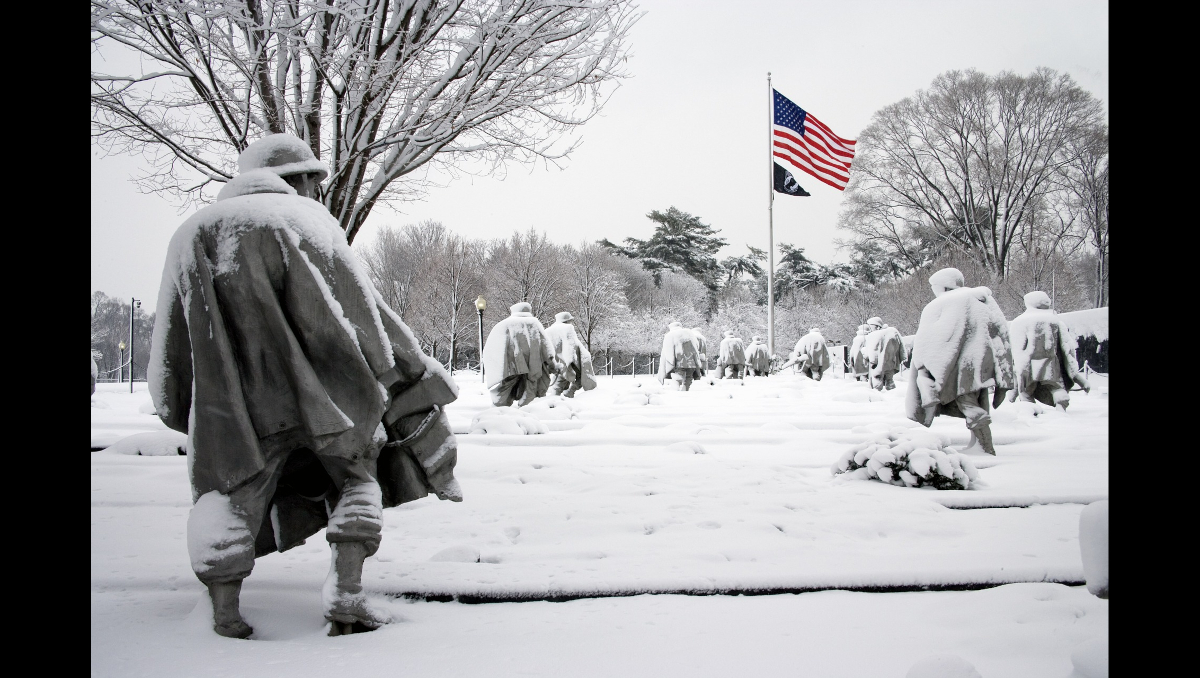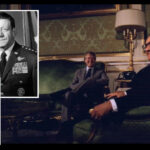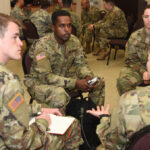
The beginning of the Cold War between the United States and the Soviet Union in 1947 set the stage for the first “hot war” in Korea.
June 25, 2025, marks the 75th anniversary of the start of the Korean War, a war which technically continues. This date is so impactful that South Koreans refer to this war that continues to divide their homeland as the “6-2-5 War,” or simply as the numbers “6-2-5” (pronounced “yook-ee-o”). With over 1.2 million South Korean lives lost—both military and civilian—the Korean War wasn’t just a national crisis; it was a deeply personal catastrophe etched into the memory of nearly every household. In the United States, it is often referred to as “The Forgotten War,” a tragic misnomer considering over 36,000 Americans lost their lives in just three years. While less than the 58,000 Americans killed in Vietnam over 20 years, the toll reveals the striking intensity and rapid escalation of combat in Korea. But Americans and Koreans were not the only ones to experience loss, as the Korean War also served as the first real test of the United Nations as a military entity, with 14 other countries providing combat units under the United Nations Command, sustaining 3,100 dead.
The losses serve as a grave reminder of a war that offers many lessons. Just two takeaways are offered here: 1) gaps in preparedness invite aggression with the cost of restoring deterrence paid in blood, and 2) the remarkable recovery of the Republic of Korea (South Korea), underwritten by the long-term commitment of the United States, speaks to the continuing relevance of the ROK-U.S. alliance—and other alliances—in today’s volatile environment. While deterrence failed in 1950, this robust alliance has prevented the resumption of hostilities on the Korean Peninsula since. Thus, seventy-five years on, the Korean War offers the United States and its allies pertinent lessons about the role of force posture and readiness for achieving deterrence in a world featuring the same players, just at a different time.
The beginning of the Cold War between the United States and the Soviet Union in 1947 set the stage for the first “hot war” in Korea. This war would see communist-aligned North Korea (backed by Russia and China) square off against the United Nations Command-backed South Korea (de facto U.S.-led) along the 38th parallel. Prior to the invasion, the United States transferred the several army divisions that had been in Korea to Japan to oversee occupation and rebuilding efforts there. In the pre-dawn hours of June 25, 1950 North Korean forces, with Russian consent, mounted a surprise attack in which they encountered the reality of the U.S. post-World War II drawdown, which left only U.S. advisors and no combat divisions supporting South Korean forces. It took only three days for the capital of Seoul to fall, and it would take until 1 July for the first U.S. reinforcements to arrive in the form of Task Force Smith.
The next three years would see dramatic shifts in territorial control as the North Koreans forced the U.S.-led coalition into the southeastern-most city of Busan, then retreated to the Chinese border of the Yalu River, before counter-attacking back to the 38th parallel with Chinese assistance. The Forgotten War illustrates a simple—but not easy—lesson: deterrence requires forward-postured, capable forces and vigilance. Ultimately, deterrence fails when capability and will are in doubt.
Another lesson emerges here, revealing the power and potential of the U.S. alliance framework for mutual prosperity and security—prosperous nations aligned with the United States are not only better equipped to contribute to their own defense, but also to contribute to the collective security of the international system. Not only did the U.S.-led coalition restore the status quo ante bellum in terms of territory, but over time the entire weight of the U.S. instruments of national power were brought to bear, in cooperation with the Republic of Korea, to restore deterrence, establish a vibrant democracy, and transform a war-ravaged nation into the global technology and cultural powerhouse it is today.
An economic comparison between North and South Korea reinforces the compounding effects of partnership with the United States. South Korea, known as “the Miracle on the Han River,” evolved from a post-war per capita income of less than $100, to the world’s 13th largest economy. On the other hand, North Korea, despite sharing ethnic homogeneity and basic geographic position, ranks 89th. Not only is South Korea thriving economically, but it contributes globally to deterrence, security, and peace— unlike its northern neighbor, which is widely regarded as a destabilizing global pariah. South Korea provides over $1 billion annually to host 28,500 U.S. servicemembers and crossed $14 billion of annual defense exports to 12 countries in 2023. The Republic of Korea has been a reliable security exporter and global partner by contributing coalition forces to Vietnam, Afghanistan, Iraq, anti-piracy operations, and peacekeeping operations. The takeaway is clear: alliances rooted in shared values and sustained through mutual investment are not only strategic assets and in the interests of the United States, they are also engines of transformation that multiply power, boost deterrence, and shape a more stable global order.
But South Korea still balances on the edge of several knives. While the ROK-U.S. alliance enforces an armistice that secures a fragile peace in a war that has not officially ended, skirmishes continue along the 155-mile blade designated as the demilitarized zone (DMZ). Occasional provocations by a nuclear-armed North Korea threaten to slice open the seams of conflict; as of this writing, North Korea conducted at least five missile launch events in 2025, including an alleged new hypersonic missile. Not only is deterrence and security of South Korea important to the Korean Peninsula, but it also represents an island of stability in a troubled region, where South Korea sits on a broader strategic knife-edge. The strategic geography of the Korean peninsula makes it a fulcrum in the Indo-Pacific—bordering China, Russia, and Japan. The commitment of military personnel in Korea not only deters North Korean aggression and its nuclear ambitions, but also serves as a regional hedge against China and Russia, especially with the Republic of Korea’s role in regional security frameworks such as U.S.-ROK-Japan trilateral cooperation.
Is the United States postured with the right forces in the right places?
Therefore, as policymakers and military leaders reflect on the start of the Korean War 75 years ago—a fiery eruption that receded into a perpetual simmer—we can draw parallels to current events and ask questions about future scenarios. In his memoirs, President Harry Truman stated the decision to help South Korea was intended to prevent its collapse, which would, in turn, encourage “China and the Soviet Union to attack other nations, resulting in World War III.” The same logic applies today with the Russia-Ukraine war and a potential China-Taiwan conflict. The U.S. military has attempted to pivot to the Pacific for over a decade. However, many Americans still grapple with the reality of China’s rhetoric, preparation, and exercises to invade its democratic neighbor, Taiwan. Certainly, parallels can be drawn between the Korean War and Russia’s invasion of Ukraine, but we should view Russia’s ambitions in broader terms. Some agree with the opinion of Hamish de Bretton-Gordon, a retired British Army officer, that Russian President Vladimir Putin’s invasion of Ukraine “brought the Cold War back to Europe, which could at any time turn hot.” Other experts, such as former deputy national security advisor Elliott Abrams, take a broader perspective, arguing that a “new Cold War” has been “brought upon the West by the aggressive partnership of Xi Jinping and Vladimir Putin.” Yet others, such as historian Philip Zelikow, imply we are potentially in the opening phases of World War III. If this is the case, then we may be where we started prior to the Korean War, and would be wise to consider This Kind of War, where T.R. Fehrenbach surmises,
Because the American people have traditionally taken a warlike, but not military, attitude to battle, and because they have always coupled a certain belligerence—no American likes being pushed around—with a complete unwillingness to prepare for combat, the Korean War was difficult, perhaps the most difficult in their history.
These words by Fehrenbach cut like a knife, one that remains sharp if we were to use them to examine America’s current preparedness for war. Is the United States postured with the right forces in the right places? Are decision-makers and military leaders vigilant and clear-eyed on the prospects for conflict with Russia and China? And finally, is the American public ready to stomach the costs of war if it is necessary?
While not the case on June 25, 1950, the U.S.-ROK alliance today serves as an excellent example of deterrence through forward posture, capable forces, and vigilance. The United States should strengthen this and other key alliances to promote economic strength, political stability, and technological advancement, which enables U.S. allies to build capable, professional militaries; invest in interoperable defense systems; and participate meaningfully in joint operations and peacekeeping. The U.S. alliance system thus becomes more than the sum of its individual parts—instead it evolves into a tightly woven mesh of burden-sharing states that reinforce regional stability, respond to crises, and reinforce the rules-based international order. In the end America and its allies can reinforce the shield of deterrence with forward postured, capable forces, possessing the will and capability to defend our interests and prove the lessons of the Korean War are not forgotten.
Andy Bogusky is an Air Force colonel and a Faculty Instructor in the Department of Military Strategy, Planning and Operations at the U.S. Army War College. A B-52 and MQ-9 pilot, he is the President of the Pennsylvania Chapter of the Korea Defense Veterans Association.
John Nagl is Professor of Warfighting Studies at the U.S. Army War College. He is the author of Learning to Eat Soup with a Knife: Counterinsurgency Lessons from Malaya and Vietnam.
The views expressed in this article are those of the author and do not necessarily reflect those of the U.S. Army War College, the U.S. Army, or the Department of Defense.
Photo Description: The Korean War Veterans Memorial in Washington, D.C., honors the sacrifices of those who served in the Korean War (1950-1953). It features 19 stainless steel statues of soldiers, a mural wall with etched faces, and a Pool of Remembrance.
Photo Credit: Pixabay





With regard to S. Korea, and many other things, does it matter that the “context” — of the Cold War when compared to today — this seems to be so amazingly different/seems to have changed so dramatically?
In this regard consider, first, the following — which might be thought of as the context, within which, the Cold War was viewed? Here, I present only one item :
1. “The United States and the Soviet Union face each other not only as two great powers which in the traditional ways compete for advantage. They also face each other as the fountain heads of two hostile and incompatible ideologies, systems of government and ways of life, each trying to expand the reach of its respective political values and institutions and to prevent the expansion of the other. Thus the cold war has not only been a conflict between two world powers but also a contest between two secular religions. And, like the religious wars of the seventeenth century, the war between communism and democracy does not respect national boundaries. It finds enemies and allies in all countries, opposing the one and supporting the other regardless of the niceties of international law. Here is the dynamic force which has led the two superpowers to intervene all over the global, sometimes surreptitiously, sometimes openly, sometimes with the accepted methods of domestic pressure and propaganda, sometimes with the frowned-upon instruments of covert subversion and open force.” (See Hans Morgenthau’s — 1967 — “To Intervene or Not to Intervene.”)
Next, consider what might be called, today, the amazingly different context, within which, we seem to find ourselves in today. (This time, I present three items.):
1. “On Dec. 4, 2023, the Chinese embassy in Washington sent a letter to select Americans explaining their government’s view of the just-concluded summit with President Joe Biden in San Francisco (actually in Woodside, in San Mateo County). The Chinese regarded the summit as ‘historic,’ that it ‘fostered a future-oriented San Francisco vision.’
In the Chinese version, they offer a path of mutual respect. Each side can ‘coexist in peace and pursue win-win cooperation.’ Biden, the embassy explained, seemed to agree. He told them, they say, that the United States ‘does not seek a new Cold War, does not seek to change China’s system, does not seek to revitalize its alliances against China, does not support Taiwan independence, and has no intention to have a conflict with China.’ ” (See the “San Francisco Vision” section of the Texas National Security Review paper: “Confronting Another Axis? History, Humility, and Wishful Thinking,” by Philip Zelikow.)
2. “We do not expect diverse countries to share the same cultures, traditions, or even systems of government. But we do expect all nations to uphold these two core sovereign duties: to respect the interests of their own people and the rights of every other sovereign nation. This is the beautiful vision of this institution, and this is foundation for cooperation and success.
Strong, sovereign nations let diverse countries with different values, different cultures, and different dreams not just coexist, but work side by side on the basis of mutual respect.”
(See about the 15th and 16th paragraphs of the White House transcript of the Trump 2017 speech to the United Nations General Assembly.)
3. “But having returned to office for a second term, Trump has changed tack. His approach remains abrasive and confrontational. He does not hesitate to threaten punishment—often economic—to force others to do what he wants. Instead of trying to beat China and Russia, however, Trump now wants to persuade them to work with him to manage international order. What he is telling now is a narrative of collusion, not competition; a story of acting in concert. After a call with Xi in mid-January, Trump wrote on Truth Social, ‘We will solve many problems together, and starting immediately. We discussed balancing Trade, fentanyl, TikTok, and many other subjects. President Xi and I will do everything possible to make the World more peaceful and safe!’ Addressing business leaders gathered in Davos, Switzerland, that month, Trump mused that ‘China can help us stop the war with, in particular, Russia-Ukraine. And they have a great deal of power over that situation, and we’ll work with them.’ ” (In the May-June 2025 issue of Foreign Affairs, see the lead article “The Rise and Fall of Great-Power Competition: Trump’s New Spheres of Influence,” by Stacie E. Goddard)
To conclude: In viewing the above, does it not become clear that:
a. While during the Cold War, the context was “a conflict between two hostile and incompatible ideologies, systems of government and ways of life, each trying to expand the reach of its respective political values and institutions and to prevent the expansion of the other” and, thus, was “a contest between two secular religions.”
b. Today, neither this such rivalry, contest and context — nor anything like it — seems to exist? Today, in sharp contrast, everyone seems to, in large part, be on the same page/on the same sheet of music?
(In this regard, what are the ramifications, for nations such as S. Korea, et. al?)
In my initial comment above, I suggest that the context, within which the Korean War occurs, this is the context of the Cold War and, thus, is the context of the conflict between “two hostile and incompatible ideologies, systems of government and ways of life, each trying to expand the reach of its respective political values and institutions and to prevent the expansion of the other.”
Also in my initial comment above, I suggest that nothing like this context seems to exist today and that, in place of same, today’s context seems to be one in which almost everyone of consequence (to include the U.S.), almost everywhere, seems to be much on the same page/much on the same sheet of music.
What then, today, is this same page/is this same sheet of music, to wit: the “context,” within which, (a) one finds many important nations agreeing with one another more now — and thus –(b) one in which we might try to discuss contemporary questions, for example, relating to Korea?
In this regard, consider the contemporary context of “civilization” and (a) the power, influence, control, privilege, prestige, status, safety and security that was and is derived by people and nations from same, and which (b) are threatened — today as before the Cold War — by such things as liberalism. (Herein, during the Cold War, communism posing the gravest threat to civilizations?)
As to this such “threat” suggestion, consider the two offerings provided below:
“All in all, the 1980s and 1990s were a Hayekian moment, when his once untimely liberalism came to be seen as timely. The intensification of market competition, internally and within each nation, created a more innovative and dynamic brand of capitalism. That in turn gave rise to a new chorus of laments that, as we have seen, have recurred since the eighteenth century: Community was breaking down; traditional ways of life were being destroyed; identities were thrown into question; solidarity was being undermined; egoism unleashed; wealth made conspicuous amid new inequality; philistinism was triumphant.” (From the book “The Mind and the Market: Capitalism in Western Thought” by Jerry Z. Muller; therein, look to near the end of the section on Friedrich Hayek)
“Capitalism is the most successful wealth-creating economic system that the world has ever known; no other system, as the distinguished economist Joseph Schumpeter pointed out, has benefited ‘the common people’ as much. Capitalism, he observed, creates wealth through advancing continuously to every higher levels of productivity and technological sophistication; this process requires that the ‘old’ be destroyed before the ‘new’ can take over. … This process of ‘creative destruction,’ to use Schumpeter’s term, produces many winners but also many losers, at least in the short term, and poses a serious threat to traditional social values, beliefs, and institutions.” (From the very first page, of the very first chapter [the Introduction chapter] of the book “The Challenge of the Global Capitalism: The World Economy in the 21st Century” by Robert Gilpin.)
Conclusion: If, both before and after the Cold War, the gravest threat to civilizations — and to each civilizations time-honored values, attitudes, beliefs, institutions, etc. — if this such “gravest threat” was then and is now liberalism (see Muller and Gilpin immediately above). And if civilizations today are now making a comeback against liberalism. Then is not THIS phenomenon/contest the context, within which, we might need to entertain questions relating to Korea, et. al, today?
Regarding my thoughts immediately above, that the contest between, shall we say, civilizationism and liberalism, this may be the new context which dominates today; regarding this such idea, what are some of the characteristics of this new civilizationism, that we should be most concerned with? As to that such specific question, consider the following:
“Discourses and practices reproducing a world where a plurality of distinct civilizations clash or dialogue, rise or fall, color multiple facets of global politics today. How should we interpret this unexpected surge in civilizational politics, especially notable in the United States, Europe, the Middle East, China, and Russia? … This paper shows how civilizationism provides an ideological path for resisting and contesting the liberal standard of civilization by articulating a distinct and valued (essentialized) sense of collective belonging, and an alternative (generally illiberal) normative system and (broadly multipolar) vision of international order. …” (See the “Abstract” of the article “Civilizationism and the Ideological Contestation of the Liberal International Order, by Gregorio Bettiza , Derek Bolton , David Lewis, in
“International Studies Review,” Volume 25, Issue 2, June 2023.)
Question — Based on the Above:
If nearly everyone of consequence, everywhere, (the United States, Europe, the Middle East, China, Russia, add India) is embracing this concept (to wit; civilizationism), whose main characteristics are (a) a generally non-liberal sense of collective belonging, (b) a general illiberal normative system and (c) a broadly multipolar vision of international order,
Then, within this such context, which seems to be being embraced by such entities as the U.S., Europe, the Middle East, China, Russia, India, etc., today, what should we expect (and, accordingly, what should we be planning and preparing for) re: such nations as S. Korea, N. Korea — etc., etc., etc. — today?
With regard to my comments immediately above, let us see what AI has to say about a context consisting of (a) an agreed-upon illiberalism and (b) an agreed-upon multipolar international order:
1. Agreed-upon illiberalism:
Definition:
It describes a situation where states, even if they don’t explicitly form an alliance, find common ground in their rejection of liberal democratic principles, human rights norms, and the rules-based international order often associated with the West.
Examples:
This can include countries with authoritarian regimes, like China and Russia, as well as populist or nationalist movements that challenge liberal democratic institutions and norms within their own countries and internationally.
Implications:
It suggests that a shared commitment to certain practical outcomes might outweigh ideological differences, leading to a more pragmatic and less ideologically driven international order. …
2. Multipolar International Order:
Definition:
A multipolar international order is characterized by the presence of multiple power centers, or ‘poles,’ with significant influence in global affairs, rather than a single dominant power.
Contrast with Unipolarity:
This contrasts with the post-World War II era, often described as unipolar, where the United States held a dominant position in global affairs. …
3. Relationship between the two concepts:
Convergence of Interests:
The rise of agreed upon illiberalism can be seen as a consequence of the shift towards a multipolar world. States with authoritarian or illiberal tendencies may find common ground in challenging the existing liberal international order and promoting their own models of governance.
Mutual Reinforcement:
The emergence of a multipolar world can create space for illiberal actors to assert their influence and challenge the liberal order. Conversely, the spread of illiberalism can further destabilize the existing international order and contribute to a more fragmented and competitive multipolar world. … ”
Conclusion: Thus, again, if the context today is one in which there is (a) an agreed-upon illiberalism and (b) an agreed-upon multipolar international order, then what are the implications of this such a new context, as relates, for example, to such entities as S. Korea (etc., etc., etc.), and our relationship(s) with same?
To better understand the first part of the Korean conflict please read my article “The US Air Force and Army in Korea: How Army Decisions Limited Airpower Effectiveness” in The Joint Force Quarterly, 91, 4th Quarter 2018. Army decisions impacted airpower effectiveness and cost the US Army many lives.